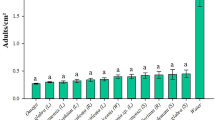Abstract
The level of susceptibility of the two-spotted spider mite, Tetranychus urticae Koch, populations collected from greenhouses in Antalya and Isparta regions of Turkey against chlorpyrifos was determined by a petri dish bioassay method. This study consisted of two stages. In the first stage, using a diagnostic dosage (0.026 ml chlorpyrifos in 100 ml distilled water) it was determined whether these populations are resistant or susceptible to chlorpyrifos. Then, different dosages of chlorpyrifos were applied to resistant populations to determine LC50 and LC90 values. Resistant ratios of populations were calculated by dividing the LC50 values of resistant populations by that of a susceptible population of T. urticae strain GSS. The resistance ratio of T. urticae populations collected from greenhouses ranged from 8.00 to 1,774.00. Results show that while three of the populations gathered from the Isparta region, where greenhouse vegetable growing has been increasing since 2000, are susceptible, two of them are only partially resistant to chlorpyrifos. On the other hand, all the two-spotted spider mite populations collected from the Antalya region, the centre of greenhouse vegetable production for many years, were found to be highly resistant to chlorpyrifos.
Similar content being viewed by others
References
Anonymous (1969) Recommended methods for the detection and measurement of resistance of agricultural pests to pesticides. FAO Plant Prod Bull 17:76–82
Anonymous (2002) Plant protection products. Ministry of Agriculture, General Directorate of Protection and Control
Ay R (2001) Investigations on resistance of different populations of Tetranychus urticae Koch (Acari: Tetranychidae) against some insecticide. PhD thesis. Ankara University
Brazle JR, Godfrey LD, Godwell PB, Grafton-Cardwel B (1998) Insecticide resistance management in San Joaquin Valley cotton. Resistance management guidelines. University of California, Calif., pp 1–23
Campos F, Dybas RA, Krupa DA (1995) Susceptibility of two-spotted spider mite (Acari: Tetranychidae) populations in California to abamectin. J Econ Entomol 88(2):225–231
Campos F, Krupa DA, Dybas RA (1996) Susceptibility of population of two-spotted spider mites (Acari: Tetranychidae) from Florida, Holland, and the Canary Islands to abamectin and characterization of abamectin resistance. J Econ Entomol 89(3):594–601
Campos F, Krupa DA, Jansson R (1997) Evaluation of petri plate assay for assessment of abamectin susceptibility in Tetranychus urticae (Acari: Tetranychidae). J Econ Entomol 90(3):742–746
Denholm I, Sawicki RM, Farnham AW (1984) The relationship between insecticide resistance and control failure. Proceedings of the 1984 British Crop Protection Conference on Pest and Diseases, Brighton. pp 527–534
Dennehy TJ, Grafton-Cardwell EE, Granett J, Barbour K (1987) Practitioner-assessable biosassay for detection of dicofol resistance in spider mites (Acari: Tetranychidae). J Econ Entomol 80(5):998–1003
Dennehy TJ, Farnham AW, Denholm I (1993) The microimmersion bioassay: a novel method for the topical application of pesticides to spider mites. Pestic Sci 9:47–54
Düzgüneş Z, Çobanoğlu S (1983) The life history and tables of Tetranychus urticae Koch and Tetranychus cinnabarinus (Boisduval) (Acarina: Tetyranychidae) under the various temperatures and humidities. Plant Prot Bull 23(4):171–187
Herron GA, Rophail J (1998) Tebufenpyrad (Pyranica) resistance detected in two-spotted spider mite Tetranychus urticae Koch (Acarina: Tetranychidae) from apples in western Australia. Exp Appl Acarol 22:633–641
Herron GA, Edge VE, Wilson LJ, Rophail J (1998) Organophosphate resistance in spider mites (Acari: Tetranychidae) from cotton in Australia. Exp Appl Acarol 22:17–30
Hoyt SC, Westigard PH, Croft BA (1985) Cyhexatin resistance in Oregon populations of Tetranychus urticae Koch (Acarina: Tetranychidae). J Econ Entomol 78:656–659
Kabir KH, Chapman RB (1997) Operational and biological factors influencing responses of spider mites (Acari: Tetranychidae) to propargite by using the petri dish–Potter tower method. J Econ Entomol 90(2):272–277
Keena MA, Granett J (1987) Cyhexatin and propargite resistance in populations of spider mites (Acari: Tetranychidae) from California almonds. J Econ Entomol 80:560–564
LeOra Software (1994) POLO-PC: a user’s guide to probit or logit analysis. LeOra Software, Berkeley, Calif.
Rizzieri DA, Dennehy TJ, Glover TJ (1988) Genetic analysis of dicofol resistance in two populations of two-spotted spider mite (Acari: Tetranychidae) from New York apple orchards. J Econ Entomol 81(5):1271–1276
Sawicki RM, Denholm I (1987) Management of resistance to pesticides in cotton pests. Trop Pest Manage 33(4):262–272
Smegal DC (2000) Human health risk assessments Chlorpyrifos, USA, EPA. Available at http://www.epa.gov/pesticides/op/chlorpyrifos/hedrra.pdf
Tian T, Grafton-Cardwel EE, Granett J (1992) Resistance of Tetranychus urticae Koch (Acari: Tetranychidae) to cyhexatin and fenbutatin-oxide in California pears. J Econ Entomol 85(6):2088–2095
Acknowledgements
This project (TOGTAG-2968) is partly supported by the Scientific and Technical Research Council of Turkey. The authors wish to thank Dr Philippe Auger of ENSA-M/INRA (France) for the identification of T. urticae and Dr Bayram Cevik for critically reading the manuscript and for suggestions which improved the language.
Author information
Authors and Affiliations
Corresponding author
Rights and permissions
About this article
Cite this article
Ay, R. Determination of susceptibility and resistance of some greenhouse populations of Tetranychus urticae Koch to chlorpyrifos (Dursban 4) by the petri dish–Potter tower method. J Pest Sci 78, 139–143 (2005). https://doi.org/10.1007/s10340-005-0084-7
Received:
Published:
Issue Date:
DOI: https://doi.org/10.1007/s10340-005-0084-7




